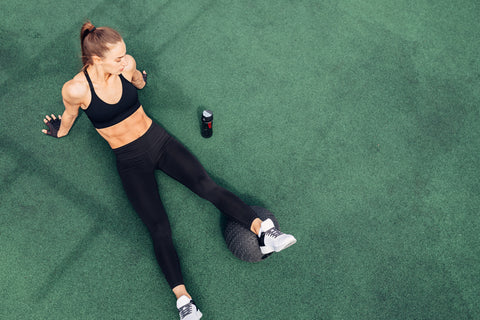HIIT stands for High-Intensity Interval Training and has become a very popular workout in recent years. Not only can you do HIIT virtually anywhere with little to no equipment, but you can easily modify it to your fitness level.
When done correctly and safely, HIIT can be a very effective tool for improving cardiovascular endurance and muscle strength in a shorter time than steady-state cardio. However, not every workout labeled "HIIT" is truly HIIT. Keep reading to learn what true HIIT is and how to add it to your training regimen to maximize its benefits.

Structure of HIIT
One reason this high-intensity workout is popular is because the structure is relatively simple and keeps your mind and body engaged throughout. Boiled down, HIIT consists of alternating, short bursts of exercise and total rest for a set duration.There are five components of HIIT intervals:
- interval intensity
- interval length
- recovery intensity
- recovery duration
- and workout volume
Interval Intensity: HIIT involves timed rounds of exercises designed to fatigue the cardiovascular system and develop muscle fatigue quicker than a typical weighted set. During working intervals, you want to give maximum effort for the entire duration to raise your heart rate as much as possible. The optimal average heart rate for HIIT is anywhere between 70% and 90% of your maximum heart rate, where 100% is the max your heart rate will go during full-out effort exercise with no rest time (think running away from a cheetah). That's why it's called high-intensity interval training.
Exercise Interval Length: Since you give maximum effort for the entire working interval, the interval duration will be shorter than most exercises. Most working intervals last from 20 seconds to 1 minute. Any longer than that can affect your form and lead to injury. Most follow-along workouts have an exercise interval of around 30 to 45 seconds.
Recovery Intensity: The best recovery for HIIT is to completely stop moving to allow your heart rate to slow down as much as possible during the short period. You can sit, lay down, kneel, or whatever is most comfortable for you. This total rest means that proper HIIT has no active recovery period.
Recovery Duration: Rest time should be at least 10 seconds and no more than 1 minute, with the average duration being 30 seconds (give or take 15 seconds). Shorter rest times allow you to recover between reps while keeping your heart rate elevated.
Workout Volume: The number of intervals recommended for HIIT depends on your fitness level. Generally, a session of four sets of work and rest is an excellent place to start for complete fitness beginners. For those with a very high fitness level, however, HIIT can last from 45 to 60 minutes. Because HIIT can be a huge time saver, most people opt for 20 to 30 minutes total. In terms of frequency, most physiology studies asked participants to complete 3 HIIT sessions per week. Any more than three can significantly increase injury risk.
The specific details of a HIIT workout vary depending on your fitness level and goals. If you're unsure where to start, consult a fitness professional, like a personal trainer or a healthcare provider. They can assess your fitness level and recommend a good starting point.

Benefits of HIIT
One of the most apparent benefits of HIIT is the shorter time it takes to achieve a good workout. A quick 20 minutes of HIIT can achieve similar benefits as 45 minutes of jogging or moderate-intensity continuous training (MCT).
This time save happens because of the relationship between exercise intensity and EPOC. Excess Post-Exercise Oxygen Consumption, or EPOC, is the amount of oxygen required to restore your body to its normal resting level of metabolic function. Also known as an afterburn effect, EPOC levels can gauge how many calories you burn during and after exercise.
EPOC increases as the exercise intensity increases. So, the intense nature of HIIT leads your body to continue to burn additional calories post-workout. In essence, your body will burn a similar amount of calories during and after HIIT as it would during a longer period of moderate-intensity exercise.
Furthermore, the max effort raises your heart rate and challenges the cardiovascular system, which can improve both aerobic and anaerobic fitness. As a result, HIIT has been shown to enhance cardiovascular health, increase VO2 max, and improve overall endurance.

Origins of HIIT (The Evolution of HIIT)
HIIT, or High-Intensity Interval Training, has hit its stride and is one of today's fastest-growing and most popular fitness forms. Known for its intensity and expedited results, it is a highly engaging fitness form that has taken the world by storm.
HIIT has roots in various training methods and has developed through different forms of interval training over the years. Here's a brief overview of the origin and evolution of HIIT:
In the 1950s, Swedish Physiologist Per-Olof Åstrand set the groundwork for alternating periods of intense effort with rest periods and its benefits for cardio fitness.
More widely known, Japanese Exercise Scientist Dr. Izumi Tabata created an interval exercise regimen for athletes in 1996. These intervals consisted of 20 seconds of all-out exercise with 10 seconds of rest for four rounds. This type of interval training is now known as the "Tabata Protocol."
Into the 2000s and present, physiologists continue to conduct studies on the effects of high-intensity interval training and its benefits compared to moderate-intensity workouts. The workout continues to gain popularity as more and more people discover it as an effective way to improve cardiovascular health in less time than a run. As our lives become busier, HIIT continues to become a great way to exercise.
Today, many fitness enthusiasts, gyms, workout classes, and coaches of various sports use HIIT and its principles as part of their fitness programs.

Is HIIT the same as Tabata?
HIIT is distinguishable from Tabata/boot camp workout formats due to mostly timing. What is widely recognized as Tabata tends to be shorter in interval and overall duration.
HIIT can be anywhere from 30-60 minutes, but Tabata cannot. Strictly speaking, Tabata is 20 seconds of work and 10 seconds of rest for eight rounds, totaling 4 minutes of exercise. So, Tabata is a format of HIIT, but not all HIIT can be qualified as a style of Tabata.
Typical HIIT timing pushes your endurance and rewards you with recovery time. However, Tabata tends to have short, quick bursts of work followed by shorter rest periods.
While both tend to push your heart rate (HR) to the high end of your cardiovascular range, Tabata usually raises your HR really high, very quickly. In contrast, typical HIIT brings you to peaks and valleys for longer periods.

How to add HIIT to your workout routine
Distinguished from CrossFit, Bodybuilding, Bootcamps, and Tabata-style training, this fitness form has a dedicated fanbase. Combining barbell and dumbbell work, functional fitness, and cardio within a high-intensity and timed environment gives you the progress of a lifting program with the mental challenge of cardio in one workout. In the fast-paced tempo we currently live in, this fitness form has found its place.
Here's how to add it to your workout routine:
1. Warm-Up
Always, always, always warm up for 5 to 10 minutes before starting HIIT, and finish your training session with a cool down and stretch for a minimum of 5 to 10 minutes.
To warm up, choose light aerobic exercises like jogging, jumping jacks, or dynamic stretches to increase heart rate and prepare the muscles for intense activity.
2. Pick Your Duration and Intervals
Start small by working at a higher effort intensity within shorter timed rounds, resting between sets. A good starting point for beginners is a 10-15 minute HIIT session with 30 seconds of work followed by 30 seconds (up to a minute) of rest. As you progress, try incrementally increasing the session duration by 5 minutes. Once you work up to 45 or 60 minutes, you're a pro. You can start with one HIIT session per week and progress up to three sessions a week.
For your safety, don't push yourself too hard. Know your limits. If you're too fatigued to maintain proper form or feel strain in your joints or tendons, slow down and rest.
3. Pick Your Moves
Most beginners choose one or two moves for HIIT. A popular move is burpees. Add some mountain climbers, jumping jacks, squats, push-ups, or jump rope for easy variety. For more intermediate and advanced moves, there is a wealth of resources online, like YouTube videos and fitness articles.
You can also easily make any lifting day more of a HIIT style by coming prepared with a program or outline of what you're working on that day. This way, you can set up your timed rounds and accurately fatigue the muscle group you want to work. Remember to go all out and as fast as you safely can during working intervals.
Or you can get your cardio up by incorporating sprint intervals or basic cardio moves into your current workout programming (such as squat jumps after heavy deadlifts or mountain climbers after a set of chest/push-ups). The possibilities are virtually endless!
Start small, or hop into a class and learn as you go! HIIT is approachable for all levels of fitness and invites all to participate.

Optional: Join a HIIT Class
If you feel formulating a HIIT session is too much, want to learn some new moves, or work out with a group, go ahead and sign up for a HIIT class! These classes are approachable for all fitness levels, and you can learn as you go. All HIIT classes at Carbon Performance in Franklin, TN, are completely judgment-free, and our instructors are here to help you get the most out of each session.


